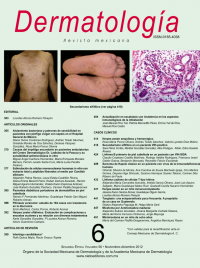RESUMEN
Antecedentes: la prevalencia de portadores asintomáticos de dermatofitos de la piel cabelluda varía de 1 a 49%, según la población estudiada. Se ha relacionado con personas que conviven con niños con tiña de la cabeza y con tiñas de otras localizaciones en el mismo sujeto. Objetivo: determinar la prevalencia de portadores asintomáticos de dermatofitos entre los pacientes con diabetes mellitus tipo 2. Pacientes y métodos: se estudiaron pacientes voluntarios con diabetes mellitus tipo 2 que participaron en la Caminata Nacional del Paciente Diabético organizada por la Clínica de Síndrome Metabólico del Instituto Nacional de Enfermedades Respiratorias, en búsqueda de alteraciones en el pelo, eritema, descamación y pústulas. Se tomaron muestras de la piel cabelluda con hisopo húmedo y se cultivaron en agar Sabouraud dextrosa con antibióticos. Resultados: se incluyeron 213 pacientes, de los cuales 158 eran mujeres (74.1%), el intervalo de edad fue de 23 a 81 años y la media de 57 años. Seis pacientes (2.8 %), cuatro mujeres y dos hombres, eran portadores asintomáticos de dermatofitos y tenían límites de edad de 52 a 75 años y media de 62.5 años. Las glucemias fueron normales. Los agentes aislados fueron: T. rubrum, en cinco pacientes, y T. mentagrophytes var mentagrophytes, en uno. Un paciente portador de T. rubrum en la piel cabelluda tuvo tiña de los pies causada por T. rubrum, y el portador de T. mentagrophytes tuvo onicomicosis del quinto dedo de un pie causada por el mismo agente. Conclusiones: la prevalencia de portadores asintomáticos de dermatofitos en la piel cabelluda es igual en pacientes con diabetes mellitus tipo 2 que en otras poblaciones. El agente aislado con más frecuencia en esta serie fue T. rubrum. Palabras clave: portadores, dermatofitos, piel cabelluda, diabetes mellitus tipo 2, Trichophyton rubrum.
Palabras clave: diabetes mellitus tipo 2, portadores, Trichophyton rubrum, dermatofitos, piel cabelluda
ABSTRACT
Background: Prevalence of asymptomatic carriers of hairy dermatophytes on the scalp varies from 1 to 49% depending on the population. It has been associated with close contact usually with tinea capitis in children. Objective: To determine the prevalence of asymptomatic carriers of dermatophytes in patients with type 2 diabetes mellitus. Patients and methods: We enrolled volunteer patients with type 2 diabetes mellitus who participated in the National Diabetic Patient Walk, a yearly marathon organized by the Metabolic Syndrome Clinic, National Institute of Respiratory Diseases. They were explored searching for alterations in the hair and scalp erythema, desquamation and/or pustules; and a sample was taken from the scalp in all of them, with a wet swab and cultured in Sabouraud dextrose agar with antibiotics. Results: We included 213 patients (158 females, 74.1%), with an age range of 23 to 81 years (average 57 years). Six patients (2.8%) were asymptomatic carriers of dermatophytes (four females) with an age range of 52 to 75 years (average 62.5 years). The glucose levels were normal. The isolated agents were: Trichophyton rubrum (five patients), and Trichophyton mentagrophytes var mentagrophytes (one patient). One patient with T. rubrum on the scalp had ringworm tinea on the feet caused by T. rubrum, and the patient with T. mentagrophytes var mentagrophytes had onychomycosis of the fifth toenail caused by T. mentagrophytes var mentagrophytes. Conclusions: prevalence of asymptomatic carriers of dermatophytes in the scalp is the same in patients with type 2 diabetes mellitus than in any other population. The most frequently isolated agent was T. rubrum. Key words: carriers, dermatophytes, scalp, type 2 diabetes mellitus, Trichophyton rubrum.
Keywords: type 2 diabetes mellitus, Trichophyton rubrum, dermatophytes, scalp, carriers

